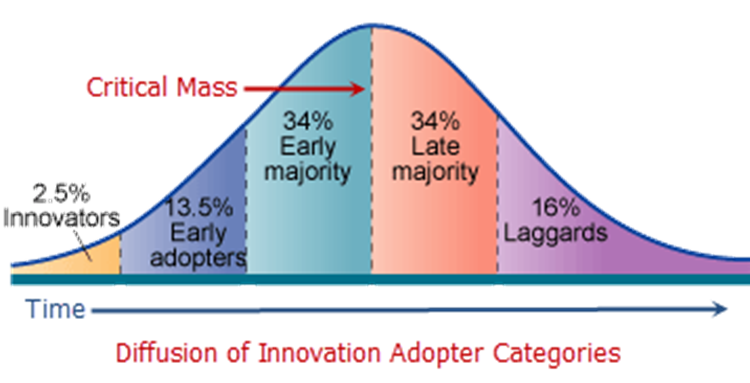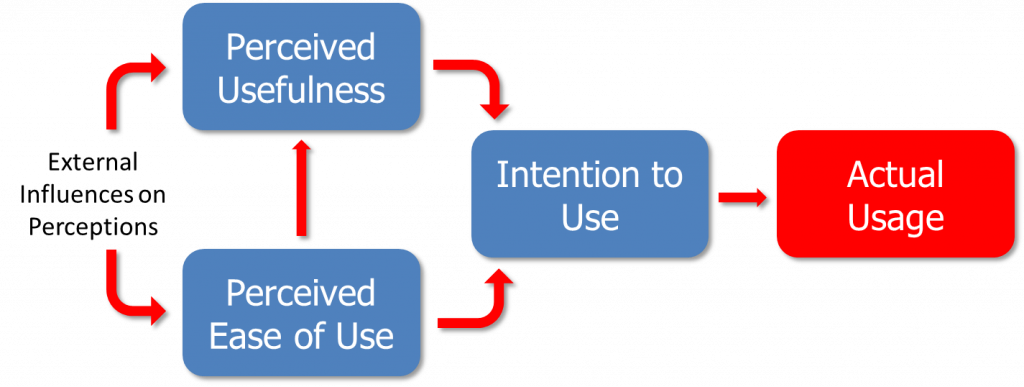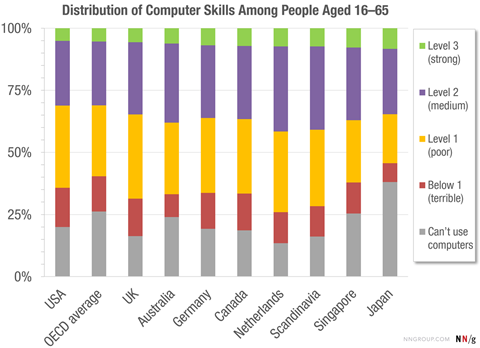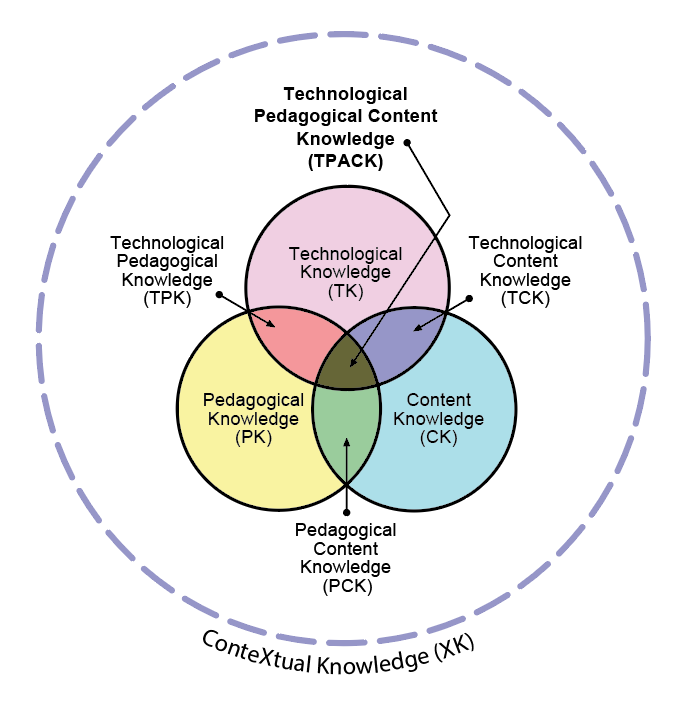
Overview
On This Page
In Week 6, we continued our exploration of common technologies used in education. You explored technologies used to facilitate synchronous communication and collaboration between students, their peers, and teachers. You also shared a presentation about the technology type(s) you have chosen for incorporation into your Technology Integration Activity project, including demonstrations of how to use current examples of those types of applications.
In Week 7, we will shift our attention to some of the issues that you will need to address if you plan to integrate technology into your teaching and learning practice. This week, we will examine the concept of diffusion of innovation, and how it relates to technology adoption within groups and organizations. We will then look at the Technology Acceptance model, and the key factors that it tells us need to be addressed before teachers and students are ready and willing to consider adopting new digital technologies. We will also briefly discuss the TPACK framework of key competencies that teachers need in order to effectively integrate technology into their practice. You will have an opportunity in this week’s Technology Exploration activities to try your hand at a simulation that will challenge you to see what works, and what doesn’t, as you try to convince teachers at a fictional school to adopt a new technology.
Topics
Week 7 is divided into three topics:
- Topic 1: Technology Integration
- Diffusion of Innovation
- The Technology Acceptance Model
- Technology Skills and Adoption/Diffusion Rates
- TPACK and Teachers’ Willingness to Adopt New Technologies
- Topic 2: Technology Exploration
- Topic 3: Community Engagement
Learning Outcomes
When you have completed this week’s activities, you should be able to:
- Describe how new technology adoption diffuses through a group or organization.
- Describe the key perceptions that need to be addressed before teachers or students are ready and willing to consider adopting new digital technologies.
- Describe how current technology skill levels amongst adults in Canada impact the potential for integration of new technologies in education.
- Describe the key competencies that a teacher must have in order to effectively integrate digital technologies into teaching and learning practice.
- Identify strategies that will and will not work when attempting to convince teachers to adopt a new technology.
Resources
Davis, F. D. (1989). Perceived usefulness, perceived ease of use, and user acceptance of information technology. MIS Quarterly, 13 (3), 319-340. https://doi.org/10.2307/249008
Indiana University, Department of Instructional Systems Technology. (2019). Diffusion simulation game. Retrieved from https://diffusion.iu.edu/
Koehler, M. J., & Mishra, P. (2006). Technological pedagogical content knowledge: A framework for teacher knowledge. Teachers College Record, 109 (6), 1017-1054. DOI: 10.1111/j.1467-9620.2006.00684.x
Koehler, M. J., & Mishra, P. (2008). Introducing TPCK. In AACTE Committee on Innovation and Technology (Ed.), Handbook of technological pedagogical content knowledge (TPCK) for educators (pp. 3-29). New York, NY: Routledge. Retrieved from http://www.punyamishra.com/wp-content/uploads/2008/05/koehler_mishra_08.pdf
Nielsen, J. (2016, November 13). The distribution of users’ computer skills: Worse than you think. Retrieved from https://www.nngroup.com/articles/computer-skill-levels/
Recker, J. (2015, February 25). Technology Acceptance Model [Video file]. Retrieved from https://youtu.be/ydIFH1q2NHw
Surry, D. W., & Farquhar, J. D. (1997). Diffusion theory and instructional technology. Journal of Instructional Science and Technology, 2 (1), 24-36. Retrieved from http://ascilite.org/archived-journals/e-jist/docs/vol2no1/article2.htm
Venkatesh, V. (2000). Determinants of perceived ease of use: Integrating control, intrinsic motivation, and emotion into the Technology Acceptance model. Information Systems Research, 11 (4), 342–365. https://doi.org/10.1287/isre.11.4.342.11872
Venkatesh, V., & Davis, F. D. (2000). A theoretical extension of the technology acceptance model: Four longitudinal field studies. Management Science, 46 (2), 186-204. https://doi.org/10.1287/mnsc.46.2.186.11926
Topic 1: Technology Integration
Diffusion of Innovation
Neither people nor organizations adopt technology into their own practices at uniform rates. Some people are keen to jump at the chance to explore new technologies as soon as they emerge. Others will “jump on the bandwagon” as they see technological enthusiasts experience success and demonstrate the benefits of new tools. Still others take a more cautious approach, waiting until new technologies become either mainstream, or mandated within an organization. And there are those who resist change, or the adoption of new technologies, for as long as they possibly can. Rogers described these technology adoption trends through the Diffusion of Innovation model, depicted below:
 Nielson, J. (2016, November 13). The distribution of users’ computer skills: Worse than you think. Retrieved from https://www.nngroup.com/articles/computer-skill-levels/
Nielson, J. (2016, November 13). The distribution of users’ computer skills: Worse than you think. Retrieved from https://www.nngroup.com/articles/computer-skill-levels/Figure 1: Diffusion of Innovation model (adapted from Rogers, 1995)
In order for any innovation—new educational technology tools included—to be successfully adopted within a school or organization, it must achieve critical mass. That is, it must get past the so-called innovators, early adopters, and early majority, and get firmly into the zone where the late majority have begun to adopt the technology.
Reading:
Read Surry and Farquhar’s (1997) “Diffusion Theory and Instructional Technology.” Surry and Farquhar apply innovation and diffusion principles to the adoption of technological innovations for teaching and learning.
- How do Surry and Farquhar describe deterministic and instrumentalist philosophies?
- How do these philosophies impact the diffusion of educational technology adoptions?
- Where do you think that you fall on the spectrum of technology adopter types? Why?
The Technology Acceptance Model
So, why is it that some teachers (and students) are less likely to adopt new technologies right away? The Technology Acceptance model (depicted below) provides some potential insights.
Figure 2: Technology Acceptance model (adapted from Davis, 1989)
Developed by Davis (1989), the Technology Acceptance model (TAM) postulates that for anyone, such as a teacher or student, to develop an intention to use a new technology, they must first:
- Perceive that the technology is useful to them.
- Perceive that they are capable of easily using the new technology.
If there are deficits in either of these two critical perceptions, people will resist the new technology.
Viewing:
Watch Jan Recker’s (2015) brief overview of the Technology Acceptance model to get a high level picture of how perceptions of usefulness and ease of use interact to influence intentions to use technology.
Recker, J. (2015, February 25). Technology Acceptance Model [Video file]. Retrieved from https://youtu.be/ydIFH1q2NHw
Then read Davis’ (1989) seminal work on TAM: “Perceived Usefulness, Perceived Ease of Use, and User Acceptance of Information Technology.”
As you watch Recker (2015) and read Davis (1989), consider:
- What types of external influences might increase a teacher or student’s perception that a new technology is useful, or easy to use?
- What role might innovators or early adopters (from the Diffusion of Innovation model) be able to play in helping to increase perceptions of usefulness, or ease of use?
Optional Readings: Extend Your Understanding
Venkatesh (2000) and Venkatesh and Davis (2000) expand on the initial TAM to describe the interactions of external influences, and how they affect perceptions of usefulness of ease of use and, ultimately, attitudes towards new technologies and intentions to integrate them into practice. With the TAM 2,Venkatesh and Davis (2000) illustrate some of the potential influences on perceptions of usefulness, while with the TAM 3, Venkatesh (2000) significantly expands on the concept of perceptions of ease of use.
Technology Skills Levels and Adoption/Diffusion Rates
Nielsen (2016) presented a summary of the results of a long-term study by the Organization for Economic Cooperation and Development (OECD, 2016) into technology skill levels in the workforces of the world’s wealthiest countries. Needless to say, the results are a stark reminder to educational technologists that we need to be very careful about how we design technology-enhanced learning experiences—because large percentages of our target users are well below the technology skill levels of typical instructional designers. The summary message was clear: You (the instructional designer/educational technologist/teacher) are NOT the user, so you cannot assume that what you think will be easy to use actually will be for the typical target user!
The following chart includes a breakdown of the technology skill levels amongst the Canadian workforce:
Figure 3: Distribution of computer skills among people aged 16–65 (Nielsen, 2016) (CC BY 3.0)
According to this chart, amongst potential Canadian adult learners, over 30% lack basic technology-related skills. A further 30% have only basic skills (i.e., they can complete simple tasks, and follow simple, explicit, step-by-step instructions).
- How do these figures compare to the user categories in Rogers’ Diffusion of Innovation model?
- What are the implications for you, as you design and develop your Technology Integration Activity project for EDDL 5101?
Reading:
Review Nielsen’s (2016) “The Distribution of Users’ Computer Skills: Worse than You Think.”
We have seen in a previous week how it is important to define our teaching and learning contexts, and to specify exactly what we want our learners to do. We can use that information to make technology integration decisions based on the suitability of different types of technology to meet our learners’ needs.
- If such large percentages of our learner audiences are at Level 1 or below according to Nielsen (2016) and OECD (2016), how does this affect our understanding of our learners’ needs?
- How does this influence your answers to some of the questions in the SECTIONS tool, or whatever checklist you used to make decisions about the technologies to incorporate into your Technology Integration Activity project?
- How does this affect your implementation plans in your forthcoming Technology Integration Activity project?
- And if our late adopters and laggards fall into the Level 1 and below technical skills categories, how does that affect what we do to get them to eventually adopt our proposed new technology integrations?
TPACK and Teachers’ Willingness to Adopt New Technologies
Koehler and Mishra’s (2006; 2008) Technological Pedagogical and Content Knowledge framework has become one of the more widely adopted frameworks for use when designing teacher professional development in the area of educational technology integration, especially in the United States. TPACK (depicted below) stipulates that, in order to effectively integrate digital technologies into teaching and learning practice, teachers must have a balance of certain key competencies, including content knowledge, pedagogical knowledge, and technological knowledge.
Figure 4: Revised version of TPACK image. © Punya Mishra, 2018. Reproduced with permission.
The Venn diagram at the heart of the TPACK framework illustrates how the three core competency areas intersect to create competency with the effective integration of technology into learning activities. But what if teachers do not feel confident with their technological knowledge? Tschannen-Moran and Woolfolk Hoy (2001) note that a lack of confidence in one’s skills—referred to
as a perception of self-efficacy—can negatively impact a teacher’s “levels of planning and organization” and willingness “to experiment with new methods to better meet the needs of students” (p. 783).
- How do technological knowledge and perceptions of self-efficacy relate to the Technology Acceptance model?
- How do they impact on the potential for reaching “critical mass” in the diffusion of innovative technologies in education?
- Where do you fall on the TPACK framework’s Venn diagram, when it comes to planning and developing your Technology Integration Activity project for EDDL 5101?
Optional Readings: Extend Your Understanding
Skim through the key points in Koehler and Mishra’s “Technological Pedagogical Content Knowledge: A Framework for Teacher Knowledge” (2006) and “Introducing TPCK” (2008). (Note: There have been numerous iterations of the TPACK acronym since it was first introduced in 2006, including the original TPCK, and the more recent TPACK.)
Topic 2: Technology Exploration
Activity 1: The Diffusion Simulation Game
Do you think you have what it takes to convince teachers and staff at a school to adopt innovative new technologies? The Diffusion Simulation Game was created by the Department of Instructional Systems Technology at Indiana University, Bloomington. The web version of the game is free to play, and challenges you to “get school teachers to adopt technology.” You are free to play the game as often as you like, and you are likely to try strategies that both will and will not work!
- Try the Diffusion Simulation Game.
- Note:
You will need to register with an email address and password to play this online simulation game.
- Note:
Write a short post on your portfolio that describes:
- Your experience playing the game.
- How many times did it take before you were happy with the number of teachers and staff you convinced to adopt a new technology?
- What strategies worked for you?
- Which ones did not?Did you learn anything from playing the game that will influence how you approach integrating technology in your own practice? In your Technology Integration Activity project?
You will be sharing and engaging with one another’s posts as part of this week’s Community Engagement activities.
Topic 3: Community Engagement
Activity 2: Discussion Questions
Your instructor will post questions in the course discussion forum related to this week’s topics. Respond to these questions, and check out (and reply to) some of the responses posted by your classmates. Feel free to use the course forum to post any thoughts or questions you may have related to this week’s readings and activities.
Activity 3: Share Your Diffusion of Innovation Portfolio Post
Share the post that you created after trying out the Diffusion Simulation Game. Be sure to check out and comment on some of your classmates’ posts.
Week 7 Summary
This week, we have looked at the theoretical models for how innovations, including the adoption of new digital technologies, spread or diffuse through groups or organizations. We have also explored some of the factors that need to align before teachers and students are ready and willing to adopt new technologies, including perceptions that the new technologies will be useful to them, and that they will have the skills to easily leverage those technologies. You have had an opportunity to put your new knowledge about these factors to use, and to try your hand at an online game that challenged you to convince simulated teachers to adopt a new technology. And you have shared your thoughts on what worked, what didn’t, and how the lessons you’ve learned might impact your plans for your Technology Integration Activity project. In the next week, we will take a look at some of the legal and ethical issues surrounding the integration of digital technologies into our teaching and learning practice. You will also undertake the next stage of your Technology Integration Activity project, and complete Assignment 4, in which you will explore in detail the technology integration issues that you will need to address in your project.
References
Davis, F. D. (1989). Perceived usefulness, perceived ease of use, and user acceptance of information technology. MIS Quarterly, 13 (3), 319-340. https://doi.org/10.2307/249008
Mishra, P., (2018). Revised version of TPACK image [Diagram]. Retrieved from https://punyamishra.com/2018/09/10/the-tpack-diagram-gets-an-upgrade/
Nielsen, J. (2016, November 13). The distribution of users’ computer skills: Worse than you think. Retrieved from https://www.nngroup.com/articles/computer-skill-levels/
OECD. (2016). Skills matter: Further results from the survey of adult skills. Paris: OECD Publishing. DOI: http://dx.doi.org/10.1787/9789264258051-en
Rogers, E. M. (1995). Diffusion of innovations (4th ed.). New York, NY: The Free Press.
Tschannen-Moran, M., & Woolfolk Hoy, A. (2001). Teacher efficacy: Capturing an elusive construct. Teaching and Teacher Education, 17 (7), 783-805. DOI: https://doi.org/10.1016/S0742-051X(01)00036-1



